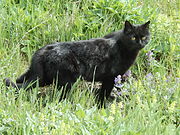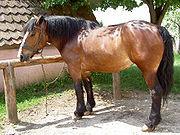Agouti coloration genetics: Difference between revisions
Iamnotabunny (talk | contribs) Create article starting from this revision (https://en.wikipedia.org/w/index.php?title=Agouti_(gene)&diff=898014083&oldid=898013673) of Agouti (gene). |
(No difference)
|
Revision as of 00:29, 13 April 2020

The agouti gene (ASIP) is responsible for variations in color in many species. Agouti interacts with extension (MC1R) to determine whether the melanocyte (pigment cell) produces the yellow to red phaeomelanin, or the brown to black eumelanin. This interaction is responsible for making distinct light and dark bands in the hairs of animals such as the agouti. In other species such as horses, it determines what parts of the body are red or black.
In many species, successive pulses of ASIP block contact between α-MSH and MC1R, resulting in alternating production of eumelanin and pheomelanin; hairs are banded light and dark as a result. In other species, ASIP is regulated such that it only occurs in certain parts of the body. The light undersides of most mammals are due to the carefully controlled action of ASIP. Additionally, the Agouti locus is the site of mutations in several species that result in black-and-tan pigmentations.[1][2]
In mice
As of 1979, there were 17 known alleles of agouti in mice.[3] Two dominant mutations on Agouti, lethal yellow and viable yellow, cause yellow coats in mice. Both of these also cause obesity, features of type II diabetes, and a higher likelihood of tumors.[4] In normal mice Agouti is only expressed in the skin during hair growth, but these dominant yellow mutations cause it to be expressed in other tissues including liver, muscle, and fat.[5]
The mouse agouti gene is found on chromosome 2.[4]
In dogs

In dogs, the agouti gene is associated with various coat colors and patterns.[6]
The alleles at the A locus are related to the production of agouti-signaling protein (ASIP) and determine whether an animal expresses an agouti appearance and, by controlling the distribution of pigment in individual hairs, what type of agouti. There are four known alleles that occur at the A locus:
- Ay = Fawn or sable (tan with black whiskers and varying amounts of black-tipped and/or all-black hairs dispersed throughout) - fawn typically referring to dogs with clearer tan and sable to those with more black shading
- aw = Wild-type agouti (each hair with 3-6 bands alternating black and tan) - also called wolf sable
- at = Tan point (black with tan patches on the face and underside) - including saddle tan (tan with a black saddle or blanket) [7][8]
- a = Recessive black (black, inhibition of phaeomelanin)
- ayt = Recombinant fawn (black with tan patches on the face and underside) has been identified in numerous Tibetan Spaniels and a Tibetan Mastiff. Its hierarchical position is not yet understood.
Most texts suggest that the dominance hierarchy for the A locus alleles appears to be as follows: Ay > aw > at > a; however, research suggests the existence of pairwise dominance/recessiveness relationships in different families and not the existence of a single hierarchy in one family.[9]
- Ay is incompletely dominant to at, so that heterozygous individuals have more black sabling, especially as puppies and Ayat can resemble the awaw phenotype. Other genes also affect how much black is in the coat.
- aw is the only allele present in many Nordic spitzes, and is not present in most other breeds.
- at includes tan point and saddle tan, both of which look tan point at birth. Modifier genes in saddle tan puppies cause a gradual reduction of the black area until the saddle tan pattern is achieved.
- a is only present in a handful of breeds. Most black dogs are black due to a K locus allele.
In cats
The dominant, wild-type A allows hairs to be banded with black and red (revealing the underlying tabby pattern), while the recessive non-agouti or "hypermelanistic" allele, a, causes black pigment production throughout the growth cycle of the hair.[10] Thus, the non-agouti genotype (aa) masks or hides the tabby pattern, although sometimes a suggestion of the underlying pattern can be seen (called "ghost striping"), especially in kittens. The sex-linked orange coloration is epistatic over agouti, and prevents the production of black pigment.
The black alleles is a 2 base pair frameshift deletion, and is thought to cause a complete loss of function of ASIP.[11][12]
In horses
In normal horses, ASIP restricts the production of eumelanin to the "points": the legs, mane, tail, ear edges, etc.[13] In 2001, researchers discovered a recessive mutation on ASIP that, when homozygous, left the horse without any functional ASIP. As a result, horses capable of producing true black pigment had uniformly black coats.[14] The dominant, wildtype allele producing bay is symbolized as A, while the recessive allele producing black is symbolized as a. Extension is epistatic over agouti and will cause chestnut coloration regardless of what agouti alleles are present.
A hypothesized third option, At, might restrict black pigment to a black-and-tan pattern called seal brown.[15] This allele would be recessive to A and dominant to a, such that horses with the genotype A/At appear bay, while At/At and At/a horses are seal brown in the presence of a dominant Extension allele E. One genetics testing lab began offering a test for At,[15] but it was later found to be inaccurate and is no longer offered.
The black allele is caused by an 11 base pair deletion in exon 2 of ASIP.[14]
In total, there are two known agouti alleles, and two more hypothesized. In order of most dominant to least, these are:
- A+ (hypothesized) would be responsible for the wild bay coat, where the black does not extend as far up the legs as in bay.
- A is responsible for the standard bay coat.
- At (hypothesized) would be responsible for the black-and-tan seal brown coat.
- a, the least dominant, is responsible for unrestricted black coat (non-agouti black).
History
The cause behind the various shades of bay, particularly the genetic factors responsible for wild bay and seal brown, have been contested for over 50 years. In 1951, zoologist Miguel Odriozola published "A los colores del caballo" in which he suggested four possible alleles for the "A" gene, A+, A, At, and a, in order of most dominant to least.[16]
This was accepted until the 1990s, when a new theory became popular.[17] The new theory suggested that shades of bay were caused by many different genes, some which lightened the coat, some which darkened it. This theory also suggested that seal brown horses were black horses with a trait called pangare. Pangaré is an ancestral trait also called "mealy", which outlines the soft or communicative parts of the horse in buff tan.
The combination of black and pangaré was dismissed as the cause of brown in 2001, when a French research team published Mutations in the agouti (ASIP), the extension (MC1R), and the brown (TYRP1) loci and their association to coat color phenotypes in horses (Equus caballus). This study used a DNA test to identify the recessive a allele on the Agouti locus, and found that none of the horses fitting the phenotype of seal brown were homozygous for the a allele.[14]
Since 2001, the mechanisms of the variations within the "bay" category remain unclear. Ongoing research suggests that Odriozola's theories may have been correct,[18] evidenced by a parallel condition in mice. Mice have several alleles at the Agouti locus, including At which produces black-and-tan.[19]
References
- ^ Drögemüller C, Giese A, Martins-Wess F, Wiedemann S, Andersson L, Brenig B, Fries R, Leeb T (January 2006). "The mutation causing the black-and-tan pigmentation phenotype of Mangalitza pigs maps to the porcine ASIP locus but does not affect its coding sequence". Mammalian Genome. 17 (1): 58–66. doi:10.1007/s00335-005-0104-1. PMID 16416091.
- ^ "at Spontaneous Allele Detail". The Jackson Laboratory. 2009-05-23. Retrieved 2009-05-26.
- ^ Silvers, Willys K. (1979). "The Agouti and Extension series of Alleles, Umbrous and Sable". The Jackson Laboratory. Springer Verlag. Retrieved 2019-05-11.
{{cite web}}: Unknown parameter|name-list-format=ignored (|name-list-style=suggested) (help) - ^ a b Cite error: The named reference
OMIM-ASIPwas invoked but never defined (see the help page). - ^ Klebig ML, Wilkinson JE, Geisler JG, Woychik RP (May 1995). "Ectopic expression of the agouti gene in transgenic mice causes obesity, features of type II diabetes, and yellow fur". Proceedings of the National Academy of Sciences of the United States of America. 92 (11): 4728–32. Bibcode:1995PNAS...92.4728K. doi:10.1073/pnas.92.11.4728. PMC 41780. PMID 7761391.
- ^ "Dog Coat Colour Genetics". www.doggenetics.co.uk. Retrieved 2017-09-25.
- ^ Dreger DL, Schmutz SM (2011). "A SINE insertion causes the black-and-tan and saddle tan phenotypes in domestic dogs". The Journal of Heredity. 102 Suppl 1: S11-8. doi:10.1093/jhered/esr042. PMID 21846741.
- ^ Dreger DL, Parker HG, Ostrander EA, Schmutz SM (2013). "Identification of a mutation that is associated with the saddle tan and black-and-tan phenotypes in Basset Hounds and Pembroke Welsh Corgis". The Journal of Heredity. 104 (3): 399–406. doi:10.1093/jhered/est012. PMID 23519866.
- ^ Kerns JA, Newton J, Berryere TG, Rubin EM, Cheng JF, Schmutz SM, Barsh GS (October 2004). "Characterization of the dog Agouti gene and a nonagoutimutation in German Shepherd Dogs". Mammalian Genome. 15 (10): 798–808. doi:10.1007/s00335-004-2377-1. PMID 15520882.
- ^ Eizirik E, Yuhki N, Johnson WE, Menotti-Raymond M, Hannah SS, O'Brien SJ (March 2003). "Molecular genetics and evolution of melanism in the cat family". Current Biology. 13 (5): 448–53. doi:10.1016/S0960-9822(03)00128-3. PMID 12620197.
- ^ Eizirik E, Yuhki N, Johnson WE, Menotti-Raymond M, Hannah SS, O'Brien SJ (2003). "Molecular genetics and evolution of melanism in the cat family". Current Biology. 13 (5): 448–53. doi:10.1016/S0960-9822(03)00128-3. PMID 12620197.
- ^ Kaelin CB, Xu X, Hong LZ, David VA, McGowan KA, Schmidt-Küntzel A, Roelke ME, Pino J, Pontius J, Cooper GM, Manuel H, Swanson WF, Marker L, Harper CK, van Dyk A, Yue B, Mullikin JC, Warren WC, Eizirik E, Kos L, O'Brien SJ, Barsh GS, Menotti-Raymond M (September 2012). "Specifying and sustaining pigmentation patterns in domestic and wild cats". Science. 337 (6101): 1536–41. Bibcode:2012Sci...337.1536K. doi:10.1126/science.1220893. PMC 3709578. PMID 22997338.
- ^ "Gene A: Distribution of Black Pigmented Hair". UC Davis Veterinary Genetics Laboratory. Retrieved 2009-05-26.
- ^ a b c Rieder S, Taourit S, Mariat D, Langlois B, Guérin G (June 2001). "Mutations in the agouti (ASIP), the extension (MC1R), and the brown (TYRP1) loci and their association to coat color phenotypes in horses (Equus caballus)". Mammalian Genome. 12 (6): 450–5. doi:10.1007/s003350020017. PMID 11353392.
The 11-bp deletion in ASIP exon 2 (ADEx2) alters the amino acid sequence and is believed to extend the regular termination signal by 210 bp to 612 bp. The frameshift initiated by the deletion results in a novel modified agouti-signaling-protein. ADEx2 was completely associated with horse recessive black coat color (Aa/Aa) in all horses typed so far
- ^ a b "Equine Testing Services". Pet DNA Services of AZ. Archived from the original on 2009-05-22. Retrieved 2009-05-26.
{{cite web}}: Unknown parameter|deadurl=ignored (|url-status=suggested) (help) - ^ Castle WE, Singleton WR (September 1961). "The palomino horse" (PDF). Genetics. 46 (9): 1143–50. PMC 1210264. PMID 13877241. Archived from the original (PDF) on 2008-09-05.
{{cite journal}}: Unknown parameter|deadurl=ignored (|url-status=suggested) (help) - ^ Kostelnik B (2007). "Starting Point". The Horse Colors Site. Archived from the original on 3 March 2008. Retrieved 2008-03-04.
- ^ Behning, Laura (2008-02-05). "The Base Colors". Morgan Colors. Archived from the original on 2008-05-17. Retrieved 2008-03-04.
{{cite web}}: Unknown parameter|deadurl=ignored (|url-status=suggested) (help); Unknown parameter|name-list-format=ignored (|name-list-style=suggested) (help) - ^ Hustad CM, Perry WL, Siracusa LD, Rasberry C, Cobb L, Cattanach BM, Kovatch R, Copeland NG, Jenkins NA (May 1995). "Molecular genetic characterization of six recessive viable alleles of the mouse agouti locus". Genetics. 140 (1): 255–65. PMC 1206552. PMID 7635290. Archived from the original on 8 September 2008.
{{cite journal}}: Unknown parameter|deadurl=ignored (|url-status=suggested) (help)
Further reading
Millar SE, Miller MW, Stevens ME, Barsh GS (October 1995). "Expression and transgenic studies of the mouse agouti gene provide insight into the mechanisms by which mammalian coat color patterns are generated". Development. 121 (10): 3223–32. PMID 7588057.




